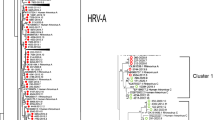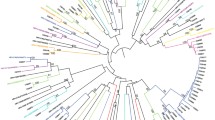Abstract
Human rhinoviruses (HRV) have been re-classified into three species (A–C), but the recently discovered HRV-C strains are not fully characterized yet. This study aimed to undertake a molecular and epidemiological characterization of HRV strains infecting children hospitalized over one year in two large research hospitals in Rome. Nasal washings from single HRV infections were retrospectively subjected to phylogenetic analysis on two genomic regions: the central part of the 5′Untranslated Region (5′UTR) and the Viral Protein (VP) 4 gene with the 5′ portion of the VP2 gene (VP4/2). Forty-five different strains were identified in 73 HRV-positive children: 55 % of the cases were HRV-A, 38 % HRV-C and only 7 % HRV-B. HRV-C cases were less frequent than HRV-A during summer months and more frequent in cases presenting wheezing with respect to HRV-A. Species distribution was similar with respect to patient age, and seasonality differed during summer months with fewer HRV-C than HRV-A cases. On admission, a significantly higher number of HRV-C cases presented with wheezing with respect to HRV-A. The inter- and intra-genotype variability in VP4/2 was higher than in 5′UTR; in particular, HRV-A patient VP4/2 sequences were highly divergent (8–14 %) at the nucleotide level from those of their reference strains, but VP4 amino acid sequence was highly conserved. In HRV-C isolates, the region preceding the initiator AUG, the amino acids involved in VP4 myristoylation, the VP4–VP2 cleavage site and the cis-acting replication element were highly conserved. Differently, VP4 amino acid conservation was significantly lower in HRV-C than in HRV-A strains, especially in the transiently exposed VP4 N-terminus. This study confirmed the high number of different HRV genotypes infecting hospitalized children over one year and reveals a greater than expected variability in HRV-C VP4 protein, potentially suggestive of differences in replication.




Similar content being viewed by others
References
Regamey N, Kaiser L (2008) Rhinovirus infections in infants: is respiratory syncytial virus ready for the challenge? Eur Respir J 32:249–251
Jackson DJ, Gangnon RE, Evans MD, Roberg KA, Anderson EL, Pappas TE, Printz MC, Lee WM, Shult PA, Reisdorf E et al (2008) Wheezing rhinovirus illnesses in early life predict asthma development in high-risk children. Am J Respir Crit Care Med 178:667–672
Miller EK, Lu X, Erdman DD, Poehling KA, Zhu Y, Griffin MR, Hartert TV, Anderson LJ, Weinberg GA, Hall CB, Iwane MK, Edwards KM, New Vaccine Surveillance Network (2007) Rhinovirus-associated hospitalizations in young children. J Infect Dis 195:773–781
Midulla F, Scagnolari C, Bonci E, Pierangeli A, Antonelli G, De Angelis D, Berardi R, Moretti C (2010) Respiratory syncytial virus, human bocavirus and rhinovirus bronchiolitis in infants. Arch Dis Child 95:35–41
Hamparian VV, Colonno RJ, Cooney MK, Dick EC, Gwaltney JM Jr, Hughes JH, Jordan WS Jr, Kapikian AZ, Mogabgab WJ, Monto A et al (1987) A collaborative report: rhinoviruses–extension of the numbering system from 89 to 100. Virology 159:191–192
Carstens EB (2010) Ratification vote on taxonomic proposals to the International Committee on Taxonomy of Viruses (2009). Arch Virol 155:133–146
Kapoor V, Liu Z, Palacios G, Ju J, Dean A, St George K, Briese T, Lipkin WI (2006) MassTag polymerase-chain-reaction detection of respiratory pathogens, including a new rhinovirus genotype, that caused influenza-like illness in New York State during 2004–2005. J Infect Dis 194:1398–1402
Arden KE, McErlean P, Nissen MD, Sloots TP, Mackay IM (2006) Frequent detection of human rhinoviruses, paramyxoviruses, coronaviruses, and bocavirus during acute respiratory tract infections. J Med Virol 78:1232–1240
Lee WM, Kiesner C, Pappas T, Lee I, Grindle K, Jartti T, Jakiela B, Lemanske RF Jr, Shult PA, Gern JE (2007) A diverse group of previously unrecognized human rhinoviruses are common causes of respiratory illnesses in infants. PLoS ONE 2:e966
Arden KE, Mackay IM (2010) Newly identified human rhinoviruses: molecular methods heat up the cold viruses. Rev Med Virol 20:156–176
Iwane MK, Prill MM, Lu X, Miller EK, Edwards KM, Hall CB, Griffin MR, Staat MA, Anderson LJ, Williams JV, Weinberg GA, Ali A, Szilagyi PG, Zhu Y, Erdman DD (2011) Human rhinovirus species associated with hospitalizations for acute respiratory illness in young US children. J Infect Dis 204:1702–1710
Bizzintino J, Lee WM, Laing IA, Vang F, Pappas T, Zhang G, Martin AC, Khoo SK, Cox DW, Geelhoed GC, McMinn PC, Goldblatt J, Gern JE, Le Souëf PN (2011) Association between human rhinovirus C and severity of acute asthma in children. Eur Respir J 37:1037–1042
Moreira LP, Kamikawa J, Watanabe AS, Carraro E, Leal E, Arruda E, Granato CF, Bellei NC (2011) Frequency of human rhinovirus species in outpatient children with acute respiratory infections at primary care level in Brazil. Pediatr Infect Dis J 30:612–614
Bochkov YA, Gern JE (2012) Clinical and molecular features of human rhinovirus C. Microbes Infect 14:485–494
Simmonds P, McIntyre C, Savolainen-Kopra C, Tapparel C, Mackay IM, Hovi T (2010) Proposals for the classification of human rhinovirus species C into genotypically assigned types. J Gen Virol 91:2409–2419
Wisdom A, Leitch EC, Gaunt E, Harvala H, Simmonds P (2009) Screening respiratory samples for detection of human rhinoviruses (HRVs) and enteroviruses: comprehensive VP4-VP2 typing reveals high incidence and genetic diversity of HRV species C. J Clin Microbiol 47:3958–3967
Peltola V, Jartti T, Putto-Laurila A, Mertsola J, Vainionpää R, Waris M, Hyypiä T, Ruuskanen O (2009) Rhinovirus infections in children: a retrospective and prospective hospital-based study. J Med Virol 81:1831–1838
Calvo C, Casas I, García-García ML, Pozo F, Reyes N, Cruz N, García-Cuenllas L, Pérez-Breña P (2010) Role of rhinovirus C respiratory infections in sick and healthy children in Spain. Pediatr Infect Dis J 29:717–720
Henquell C, Mirand A, Deusebis AL, Regagnon C, Archimbaud C, Chambon M, Bailly JL, Gourdon F, Hermet E, Dauphin JB, Labbé A, Peigue-Lafeuille H (2012) Prospective genotyping of human rhinoviruses in children and adults during the winter of 2009–2010. J Clin Virol 53:280–284
Piralla A, Rovida F, Campanini G, Rognoni V, Marchi A, Locatelli F, Gerna G (2009) Clinical severity and molecular typing of human rhinovirus C strains during a fall outbreak affecting hospitalized patients. J Clin Virol 45:311–317
Piralla A, Baldanti F, Gerna G (2011) Phylogenetic patterns of human respiratory picornavirus species, including the newly identified group C rhinoviruses, during a 1-year surveillance of a hospitalized patient population in Italy. J Clin Microbiol 49:373–376
Pierangeli A, Gentile M, Di Marco P, Pagnotti P, Scagnolari C, Trombetti S, Lo Russo L, Tromba V, Moretti C, Midulla F, Antonelli G (2007) Detection and typing by molecular techniques of respiratory viruses in children hospitalized for acute respiratory infection in Rome, Italy. J Med Virol 79:463–468
Kiang D, Kalra I, Yagi S, Louie JK, Boushey H, Boothby J, Schnurr DP (2008) Assay for 5′ noncoding region analysis of all human rhinovirus prototype strains. J Clin Microbiol 46:3736–3745
Savolainen C, Blomqvist S, Mulders MN, Hovi T (2002) Genetic clustering of all 102 human rhinovirus prototype strains: serotype 87 is close to human enterovirus 70. J Gen Virol 83:333–340
Palmenberg AC, Spiro D, Kuzmickas R, Wang S, Djikeng A, Rathe JA, Fraser-Liggett CM, Liggett SB (2009) Sequencing and analyses of all known human rhinovirus genomes reveal structure and evolution. Science 324:55–59
Posada D, Crandall KA (1998) Modeltest: testing the model of DNA substitution. Bioinformatics 14:817–818
Swofford D, Sullivan J (2003) Phylogeny inference based on parsimony and other methods with PAUP*. In: Salemi M, Vandamme AM (eds) The phylogenetic handbook-A practical approach to DNA and protein phylogeny. Cambridge University Press, New York, pp 160–206
Tamura K, Peterson D, Peterson N, Stecher G, Nei M, Kumar S (2011) MEGA5: molecular evolutionary genetics analysis using maximum likelihood, evolutionary distance, and maximum parsimony methods. Mol Biol Evol 28:2731–2739
McErlean P, Shackelton LA, Andrews E, Webster DR, Lambert SB, Nissen MD, Sloots TP, Mackay IM (2008) Distinguishing molecular features and clinical characteristics of a putative new rhinovirus species, human rhinovirus C (HRV C). PLoS ONE 3:e1847
Chow M, Newman JF, Filman D, Hogle JM, Rowlands DJ, Brown F (1987) Myristylation of picornavirus capsid protein VP4 and its structural significance. Nature 327:482–486
Savolainen-Kopra C, Blomqvist S, Smura T, Roivainen M, Hovi T, Kiang D, Kalra I, Yagi S, Louie JK, Boushey H, Boothby J, Schnurr DP (2009) 5′ noncoding region alone does not unequivocally determine genetic type of human rhinovirus strains. J Clin Microbiol 47:1278–1280
Huang T, Wang W, Bessaud M, Ren P, Sheng J, Yan H, Zhang J, Lin X, Wang Y, Delpeyroux F, Deubel V (2009) Evidence of recombination and genetic diversity in human rhinoviruses in children with acute respiratory infection. PLoS ONE 4:e6355
McIntyre CL, McWilliam Leitch EC, Savolainen-Kopra C, Hovi T, Simmonds P (2010) Analysis of genetic diversity and sites of recombination in human rhinovirus species C. J Virol 84:10297–10310
Mackay IM, Lambert SB, Faux CE, Arden KE, Nissen MD, Sloots TP, Nolan TM (2013) Community-wide, contemporaneous circulation of a broad spectrum of human rhinoviruses in healthy Australian preschool-aged children during a 12-month period. J Infect Dis 207:1433–1441
Lee WM, Lemanske RF Jr, Evans MD, Vang F, Pappas T, Gangnon R, Jackson DJ, Gern JE (2012) Human rhinovirus species and season of infection determine illness severity. Am J Respir Crit Care Med 186:886–891
Linder JE, Kraft DC, Mohamed Y, Lu Z, Heil L, Tollefson S, Saville BR, Wright PF, Williams JV, Miller EK (2013) Human rhinovirus C: age, season, and lower respiratory illness over the past 3 decades. J Allergy Clin Immunol 131:69–77
Lau SK, Yip CC, Lin AW, Lee RA, So LY, Lau YL, Chan KH, Woo PC, Yuen KY (2009) Clinical and molecular epidemiology of human rhinovirus C in children and adults in Hong Kong reveals a possible distinct human rhinovirus C subgroup. J Infect Dis 200:1096–1103
Arakawa M, Okamoto-Nakagawa R, Toda S, Tsukagoshi H, Kobayashi M, Ryo A, Mizuta K, Hasegawa S et al (2012) Molecular epidemiological study of human rhinovirus species A, B and C from patients with acute respiratory illnesses in Japan. J Med Microbiol 61:410–419
Kiang D, Yagi S, Kantardjieff KA, Kim EJ, Louie JK, Schnurr DP (2007) Molecular characterization of a variant rhinovirus from an outbreak associated with uncommonly high mortality. J Clin Virol 38:227–237
Tapparel C, Cordey S, Junier T, Farinelli L, Van Belle S, Soccal PM, Aubert JD, Zdobnov E, Kaiser L (2011) Rhinovirus genome variation during chronic upper and lower respiratory tract infections. PLoS ONE 6:e21163
Lewis JK, Bothner B, Smith TJ, Siuzdak G (1998) Antiviral agent blocks breathing of the common cold virus. Proc Natl Acad Sci USA 95:6774–6778
Tuthill TJ, Groppelli E, Hogle JM, Rowlands DJ (2010) Picornaviruses. Curr Top Microbiol Immunol 343:43–89
Katpally U, Fu TM, Freed DC, Casimiro DR, Smith TJ (2009) Antibodies to the buried N terminus of rhinovirus VP4 exhibit cross-serotypic neutralization. J Virol 83:7040–7048
Bochkov YA, Palmenberg AC, Lee WM, Rathe JA, Amineva SP, Sun X, Pasic TR, Jarjour NN, Liggett SB, Gern JE (2011) Molecular modeling, organ culture and reverse genetics for a newly identified human rhinovirus C. Nat Med 17:627–632
Acknowledgments
This study was supported by grants from Pasteur Institute, Cenci Bolognetti Foundation to G.A and from Sapienza University of Rome “Ricerche Universitarie” to C·S.
Author information
Authors and Affiliations
Corresponding author
Rights and permissions
About this article
Cite this article
Pierangeli, A., Ciccozzi, M., Chiavelli, S. et al. Molecular epidemiology and genetic diversity of human rhinovirus affecting hospitalized children in Rome. Med Microbiol Immunol 202, 303–311 (2013). https://doi.org/10.1007/s00430-013-0296-z
Received:
Accepted:
Published:
Issue Date:
DOI: https://doi.org/10.1007/s00430-013-0296-z




